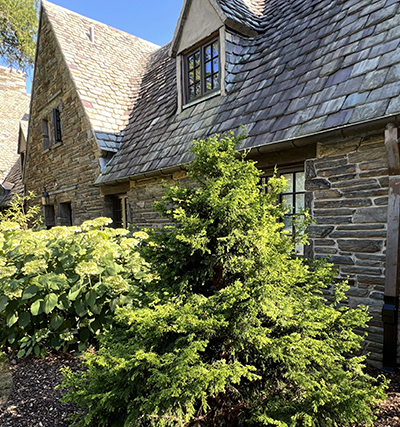Plants for the Week: September 16

Heliconia psittacorum (parrot heliconia)
Heliconia hail from tropical and subtropical climates and as such produce flowers all year long. The flower is distinctive and can range in colors from red and orange to yellow and green. The brightly colored waxy bracts are arranged alternately on the stem and enclose and protect the small flowers. Flowers produce an abundance of nectar – the color, shape, and curve are designed to attract hummingbirds. Despite its warm weather disposition, it’s an excellent pot plant, easily overwintered indoors. It’s also a popular cut flower. A containerized plant is on display at the Isbelle Cosby Courtyard.

Aristolochia clematitis (creeping birthwort)
While many Aristolochia are climbing and twining vines, capable of covering many feet in length, there are species that remain more contained in their growth. Aristolochia clematitis is one such species, averaging a few feet in growth each season. Aristolochia are known for their unusually shaped flowers. One online distributor had the following to share, “the color of the blossoms isn’t very conspicuous but its chalice-like, bag-shaped guise and the arrangement of the blossoms in the axils in a kind of whorl is very elegant and graceful. This blossom shape is called ‘basin trap flower’ as it invites the most diverse insects for pollination and captivates them in the basin until pollination has taken place. Until then, the ‘trap’ opens and the insect can escape loaded with pollen. The plant, thereby, is a good food source for many useful insects in the garden.” Several specimens are growing in the Terry Shane Teaching Garden.

Chamaecyparis obtusa ‘Sunny Swirl’ (Hinoki falsecypress)
A conifer in summer? Shocking. I say that cheekily, as conifers are often highlighted in winter, long after their deciduous kin have shed their leaves. As such, I’ve made it a personal goal to pause and be more observant of this group of plants during the active growing season. I frequently pass by Chamaecyparis obtusa ‘Sunny Swirl’ as I make my way from the Ben West parking lot to the Wister Center where it anchors a corner planting at Bond Memorial Hall. This spot is superb. Being categorized as a dwarf conifer, growing just 3 – 6 inches a year, it’s in perfect scale with the Cotswold style architect. As it’s near a paved walkway, passersby can appreciate the threadlike foliage that twists and shoots off in various directions. Tiny cockscomb growths develop at the tips, adding another degree of interest. ‘Sunny Swirl’ was discovered at Iseli Nursery as a sport on C.obtusa. ‘Torulosa’.





No Comments